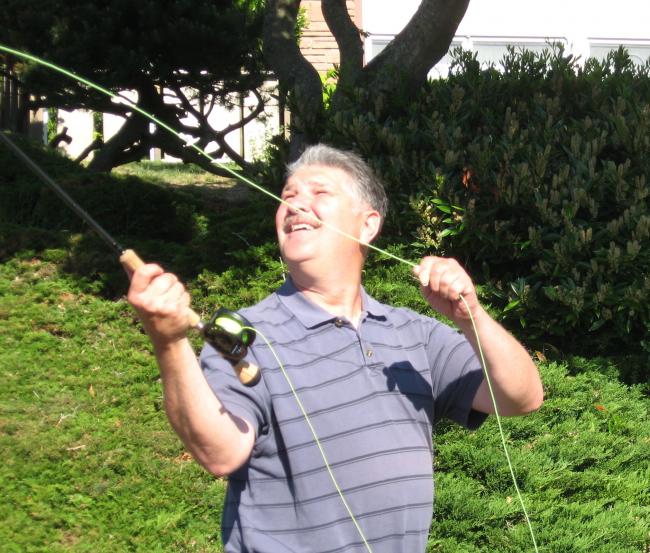At Large in Ballard: Casting from the curb
John Olson casts into the sun.
Mon, 06/01/2009
Fly fishing entered my life when John Olson parked his City of Seattle Department of Transportation backhoe along the front curb and prepared to eat lunch in the cab.
He was the advance team for the crew from the streets division dispatched to lift the concrete at the base of the alley in order to explore the void by a storm water drain (At Large in Ballard: The void).
When your vehicle is a four-ton backhoe it isn’t practical to return to the break room at Haller Lake for lunch; besides John prefers the quiet at the job site.
Excited at the appearance of equipment that could solve the sidewalk problem I waved up at John in the cab to ask questions. It seemed fitting to learn in our “street talk” that he grew up within a half a mile, back on the street where I lived for the last 21 years.
“We played baseball down your way,” he said. “The catch basins were the bases.” It was clear he really knew these streets.
Later when the rest of the concrete crew arrived, John climbed into the cab of his machine and donned ear protection while operating a pneumatic hammer drill to break up the sidewalk. While the crew on the ground poked at the revealed drain pipe he gave me a smile. John Olson has a great smile.
John was born at Ballard Hospital and went to school at Adams Elementary. He graduated from Ballard High School (1973) as did his father, and his own two children. Three generations of Ballard graduates.
In this neighborhood he recalled the phone booth that used to be in front of the Foodtown Grocery on 32nd Avenue Northwest. As a youngster he was intrigued by the hinged doors, but once he got stuck inside. A neighbor finally rescued him, put him under her arm and deposited him at home. Later on when he was learning to drive he got the car underbelly stuck on a bump in the parking lot. He doesn’t miss Foodtown.
Like so many kids growing up in Ballard in the 1960s he and his friends would play down at the beach by Ray’s. They’d fish or throw a tennis ball for a dog but then have to swim out for the ball when the dog lost interest. His father had a three stage whistle that he used to call the kids home.
With the exception of three weeks working in Idaho soon after high school, John Olson didn’t go far from Ballard. He returned from making orange juice in Idaho (“I cannot stand this”), married a Nathan Hale graduate he’d met while working as a ball field attendant and settled on Northwest 74th.
He’s worked for the City of Seattle for 28 years and had the same phone number even longer.
He eyed the street where we were standing and recalled that he almost bought a home nearby, but the street condition suggested underlying instability.
“I want a house on a street that has curbs and sidewalks because then you have good drainage," he said.
He lives in Olympic Manor, but he still owns the house that was next to his on 74th. He paid the back taxes for an elderly neighbor so that she wouldn’t lose her home; then purchased it from her family after her death. He’s had the same tenant for 19 years. When the tenant goes on vacation, John feeds his fish.
We talked while John re-attached the bucket to the backhoe and double-checked the fasteners. How did we start discussing fly-fishing? Perhaps anyone who spends time with John hears about tie end casting.
John currently teaches fly-tying at the Orvis store in Bellevue, though over the last decades he’s taught classes in Ballard and near by. His classes are geared for adults but he once taught two nine-year old boys, best friends who lived across the street from each other. His oldest student was an 87 year-old widow who had always wanted to learn. He had her come an hour early one week to work with her one-on-one, and, “She really got the hang of it.”
Every year John participates in a retreat called “Casting for Recovery,” teaching fly fishing to women recovering from breast cancer. The casting motion is therapeutic, particularly in countering effects of lymphedema that can occur after surgery involving lymph nodes. John demonstrated the motion, a sinew in the air that I couldn’t help but correlate with his controlling the pneumatic drill from 10 feet above the ground.
It was the lure of sidewalks and curbs that drew John and his family to Olympic Manor plus a 360 degree view and a veritable boulevard to practice casting. Unless he gets transferred during department changes John works the north division of Seattle, south to Denny and north to 145th. He enjoyed seeing old friends during the sidewalk project on Ballard Avenue.
With school boundaries shifting he doesn’t foresee a fourth generation of his family graduating from Ballard High School. “That’s over,” he said, along with getting his chowder fix from Gordo’s on Seaview.
He shared a final story before driving back to the Haller Lake facility in his backhoe; which takes much longer returning to the north, than descending to the south. While casting with his fly rod in front of his house he heard a neighbor take a fall. After he’d helped the neighbor and the firemen had patched him up they gathered to ply John with questions about his choice of rod and reel. One of John’s best rods cost more than his $1,000 car - but the rod will last forever.
John made another casting motion with his whole arm and then gave a wave. The backhoe took a left at the stop sign; then John and his beaming smile were gone.


